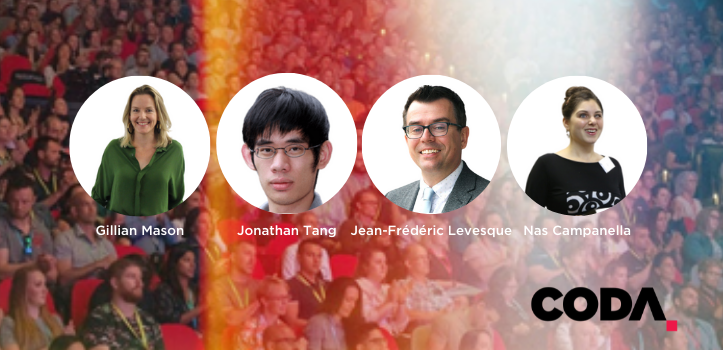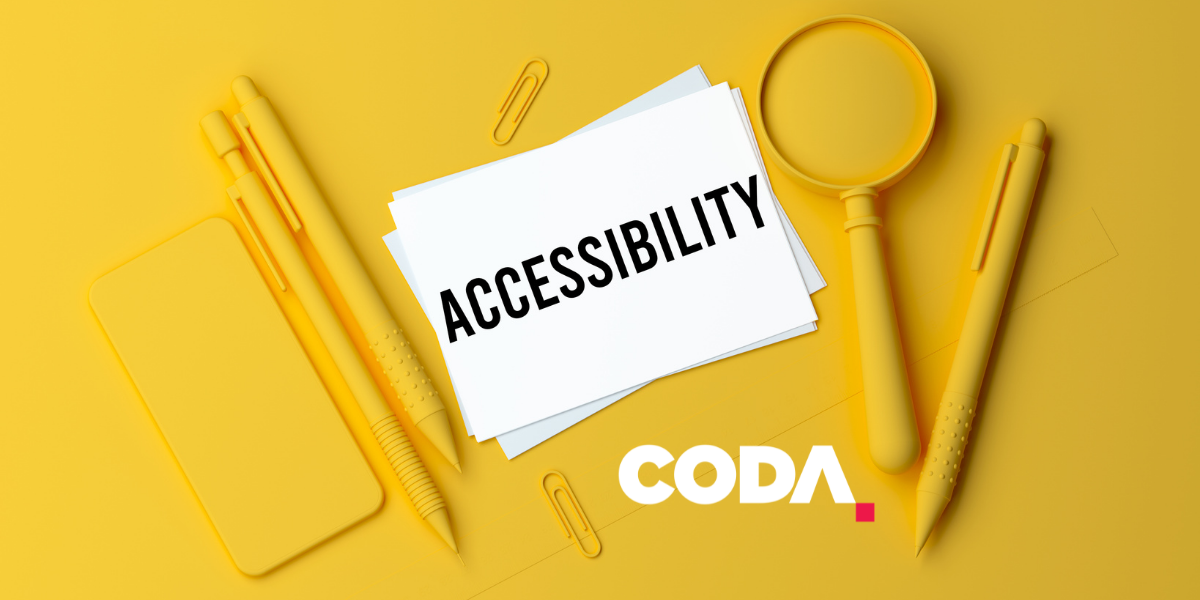Healthcare should be equitable and accessible for everyone, but what exactly is equitable access to healthcare?
Access is the ability to seek healthcare.
The ability to physically connect and to pay for healthcare.
Most importantly, access is the ability to engage with healthcare.
Open and honest communication with patients is key.
Empower people to make decisions about their own care, finding a way to communicate even if in a non-traditional way.
The reality is, a lot of clinicians live and work with disabilities themselves, yet healthcare is void of a system that caters to everyone.
It is really important as clinicians, to not just look at the numbers but to look at the patient as a whole.
We need to come together and reinvent how we deliver healthcare – to suit everyone.
For more like this, head to our podcast page. #CodaPodcast
– (Gillian) You’re also Jean-Frederic working on digital health strategy and implementation. You’ve been thinking about
workforce and how to support access for staff. Did you want to comment more on that?
– (Jean- Frederic) Yes, thank you. When we think about virtual care, we often jump to the conclusion that it is just for patients. The reality is, a lot of clinicians live and work with disabilities themselves. Virtual care needs to be something that becomes a tool for clinical practice as well.
It’s a technology that can help the interaction be completely different in terms of clinical delivery. There are two ideas or innovations that I wanted to bring to the table. If I may share my word, my word was not really original because of the title of the session, it’s accessibility.
I wanted accessibility to be my word because I was born in a very remote, isolated community in Canada. If family members needed healthcare services, including some of my family members with disabilities, the biggest problem was access to healthcare. Having to drive 12 hours to reach a centre to see the specialist for sometimes 10 minutes and then driving back, It’s not a great experience.
Then professionally, working with refugees and also experience that I’ve had in South India where I did my study. Accessibility really became a focus for me.
My first point is that we need to consider access as a journey for anyone. That journey, when we think about access, very often we just think about the clinical side of things. You know, the opening hours, the cost of care, the types of treatment that you may be able to find in the practice.
The reality is, access is determined by everyone’s ability through the healthcare seeking process.
– (Gillian) So, I just want to point out the word on the slide is the ability to and we had a lovely argument about this just in our preparation session. It’s not about getting rid of the Dis or anything like that and just seeing the ability. In terms of access requirements, people actually need to have the ability to engage, like you’re saying.
– (Jean- Frederic) Absolutely and every patient is facing many hurdles to actually obtain what’s really relevant for them. It’s about the ability
to perceive your problem and think that you can be helped by the system.
It’s the ability to seek health care. We know that many groups will be discriminated against, not being able to seek healthcare, right from the start.
Physically reaching healthcare, is obviously a hurdle for many people.
The ability to pay can be a big problem.
Then, even when patients are in the practice with us, the ability to engage, we cannot take for granted. Some people will have more difficulty expressing what they truly need.
We need new tools to make sure that clinicians can actually bridge those abilities and disabilities that people have across the entire journey so that they really truly receive what’s needed.
It’s not just the patient’s responsibility. The system has to adapt to those different abilities and the challenges that it poses for patients.
– (Gillian) It’s always made me absolutely astounded that healthcare seems to be one of the last frontiers in being more inclusive for
people with health problems. I’ve been awkward to ask for my access needs. The ABC’s advertising looking for disabled talent because it’s not just nice, but as Nas touched on, there are many advantages for employing disabled people.
In healthcare you don’t know where you can actually ask anyone for your access needs when you make an appointment.
– (Jean- Frederic) Your point is very true. There’s a cultural element that we all need to work on to create that change. There’s two things I wanted to discuss more specifically. There are things that we’re really trying to do in New South Wales to improve access to healthcare and the appropriateness of care for people with disability, as well as the entire population.
The first one of course is virtual health. We’re really trying to accelerate virtual care during COVID-19 but also we’ve been working on many different tools that would help virtual care not just be a technological add on to clinical practice. That’s not really going to work. Having an outpatient clinic where some patients may come virtually and some patients may come face to face actually requires a different way to manage appointments, manage receptions and welcome patients. The coordination with lab tests and all of those things.
So we need to think about virtual care as a redesign process. It’s not just the technology, it’s about redesigning the models of care. The way we work as multidisciplinary teams. To do that well, we’ll need to engage patients with lived experience. So that we don’t assume that as clinicians we know what’s going to be the right solution to the problems. So it’s really going to be a journey where clinicians and patients need to come together, look at the available technologies and then reinvent the way we deliver healthcare.
The second idea is the idea of patient reported measures. Patient reported experience, which is really about the way patients feel about their health care. Do they have continuity of care? Must they repeat themselves all the time when they come to see us? Do they feel respected?
It’s also about outcomes. I want to emphasise that point. Very often when we treat people with disabilities we will look at the disability
as being the main reason for complaint right from the start, it’s the default setting.
The reality is that people living with disabilities have various health problems or aspects of their health, that they would like to be considered as part of their care. What we’re doing with patient reported outcome measures and what we are currently rolling out in New South Wales, is a system that enables patients before their appointment to reflect on various aspects of their quality of life. Do they feel
a bit depressed today? Do they have more difficulty to move around compared to usual? What we want to do is for clinicians to have that information at hand when they’re in the consultation room or on the ward with patients.
Then they’ll be able to yes, address the diabetes or the specific health condition from their own specialties but also have a broader
view of the whole person and their needs.
The reality is even when we think about very visible problems or very specific health problems, we may find out that it’s other aspects of quality of life that will truly make a difference for patients.
What we want to do is really make it systematic for clinicians to access that information and be able then to engage in a conversation with patients and reflect on the current situation. How do you feel today? How can I really help you? But also reflect on progress.
So that may prompt better access to healthcare because an endocrinologist may actually be able to say “okay, you’re not moving very well right now, according to what you’re saying, is there a way I can connect you with someone? Should we follow up with another provider that you’re currently seeing?” and really promote that appropriateness of care in the practice.
Too often we focus on the specific problem and then we ignore the other things that will really make a difference.
So these are the two things I really wanted to emphasise today because I really think we could do that. These are really concrete actions we can do, we can adopt in clinical practice and really make a difference.
– (Nas) I think the important thing to note as well is that there are tools out there already to help with this. For example, a peak body that
supports autistic people, Amaze in Victoria, has just put out a guide. Partly it’s for autistic people to know the kinds of ways they can
articulate what they’re feeling, how they’re feeling, their symptoms. Either through a diary that they might keep or through story boards or drawings or whatever it might be that suits them and their needs.
It’s also for clinicians to read to understand the types of perspectives that your patients are coming to you with. So some of these tools
are already out there and they’re at your fingertips, they’re there for you to use.
– (Jono) I think it’s about focusing on what the patient wants. Touching on Nas’ story and also the Patient Reported Outcome Measures, as clinicians we like numbers. How’s the haemoglobin, is the K not too high? It doesn’t matter if they’ve got a low haemoglobin, if they can’t come into clinic because they’re just too tired. The whole point of this is to understand the patient experience. I know working with the
ACI with spinal cord injury, a lot of people out there think lack of movement is the biggest problem in spinal cord injury. Whereas if you actually asked patients, it’s not. It’s actually the bowel and bladder dysfunction. How can I get my bowels moving? How can I improve my bladder function? That is their main goal.
So at the moment, we’re trying to frame research to how to target these areas. At the same level, clinicians, you have to know what is
the most important thing. Maybe sometimes they don’t want to fix their movement. They actually want to fix some of these autonomic issues. So it’s really important as clinicians to not just look at the numbers and actually look as a patient as a whole from a holistic sense.
Nas Campanella
Nas Campanella is the ABC’s Disability Affairs Reporter. Nas is totally blind and lives with a neurological condition called Charcot-Marie-Tooth (CMT) which means she can’t read Braille. After completing a Communications degree at the University of Technology Sydney, majoring in journalism she started with the ABC as a cadet. Nas has worked as a regional reporter in south eastern New South Wales and then as a triple j newsreader for seven years. In taking on this role, Nas became the first blind newsreader in the world to read and operate the studio for herself live to air. In 2020 she was appointed to the senior national Disability Affairs role.
Jonathan Tang
Jonathan Tang is an early career researcher and clinician with a passion in the field of spinal medicine. Recognised for the ability to contribute thought leadership to the translation of research into clinical practice and the development of patient centred care from the perspective of the person with lived experience. He is currently an Intern at Royal Prince Alfred Hospital. In 2012, Jonathan broke his neck at a trampoline accident resulting in an incomplete C5 tetraplegia. Ironically, he was working as a physiotherapist in rehab at the time.
Jean-Frédéric Levesque
Jean-Frédéric has a Medical Degree, a Masters in Community Health and a Doctorate in Public Health from the Université de Montréal, Canada. He is a Fellow of the Royal College of Physicians of Canada in Preventive Medicine and Public Health. He is a member of the Strategic Analytic Advisory Committee of the Canadian Institute of Health Information and a member of the HealthShare NSW Board.
Gillian Mason
Gillian Mason (she/her), has gained insight into and lost patience with inflexible healthcare systems, managing the demands of two complex chronic diseases and a 15-year career as a physiotherapist, rehabilitation researcher and science communicator. She was born with the genetic connective tissue disorder Ehler’s Danlos Syndrome and developed Chronic Inflammatory Demyelinating Polyneuropathy a decade ago. She is a consumer representative on the Australian Government’s Medical Services Advisory Committee and Health Technology Assessment Consumer Consultative Committee and a passionate advocate for access and inclusion in healthcare. For the University of Newcastle, at Hunter Medical Research Institute, she manages the Stroke Research Register and provides training and mentorship in the involvement of consumers and the community in research. As a clinical research assistant for the Centre for Rehab Innovations, her focus is on developing solutions for delivering individualised, accessible rehabilitation, supported by telehealth and digital health applications.





